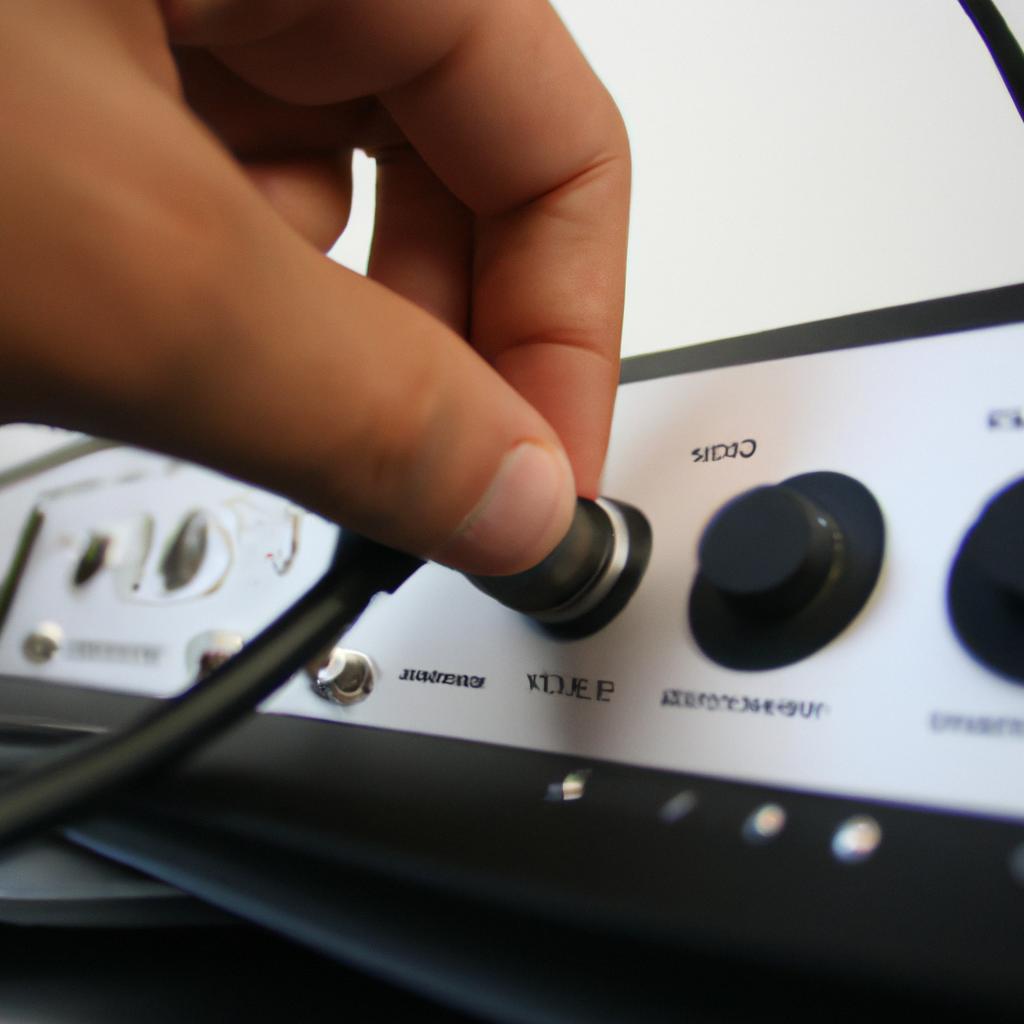In the realm of digital media services, audio streaming has emerged as a predominant method for delivering audio content to users. With the rise in popularity of music streaming platforms and podcasts, understanding the concept of bitrate becomes crucial. Bitrate refers to the amount of data transmitted per unit of time and is directly associated with the quality of audio playback. For instance, imagine a scenario where a user is listening to their favorite podcast on a streaming platform but experiences frequent interruptions or distortion in sound. This can be attributed to an inadequate bitrate that compromises the overall listening experience.
To address this issue, it is essential to delve deeper into the concept of bitrate and its implications within audio streaming services. In recent years, numerous media service providers have implemented various strategies to optimize bitrates for enhanced user satisfaction. These efforts aim at striking a balance between high-quality audio delivery and efficient use of network resources. By examining different approaches employed by industry leaders such as Spotify or Apple Music, we can gain insights into how they tackle challenges related to bandwidth limitations, varying internet speeds, and optimizing compression techniques while maintaining optimal sound fidelity.
As technology continues to advance rapidly, ensuring seamless audio streaming experiences remains paramount for media service providers. The subsequent sections will explore the significance of bitrate within audio streaming platforms further and discuss strategies employed by industry leaders to optimize bitrate for enhanced user satisfaction.
One significant aspect of bitrate optimization is the use of adaptive streaming techniques. Adaptive streaming allows audio streaming platforms to dynamically adjust the bitrate based on the user’s network conditions. This ensures a consistent playback experience, even with varying internet speeds. Spotify, for example, utilizes adaptive streaming algorithms that continuously monitor the user’s network connection and device capabilities to deliver an optimal listening experience.
Another approach to bitrate optimization involves efficient compression techniques. Audio files are compressed to reduce their size for faster transmission over networks. However, excessive compression can result in a loss of audio quality. Media service providers employ various codecs (such as AAC or MP3) and encoding parameters to strike a balance between file size and audio fidelity. Apple Music, for instance, uses the AAC codec with advanced encoding settings to achieve high-quality audio at lower bitrates.
Bandwidth limitations also play a crucial role in optimizing bitrates. Media service providers often face challenges when delivering high-quality audio to users with limited bandwidth availability. To address this issue, platforms like Spotify offer options for users to choose their preferred streaming quality, allowing them to control the amount of data consumed during playback.
Moreover, advancements in network infrastructure and technologies such as 5G are expected to further enhance bitrate optimization capabilities. With faster and more reliable connections, media service providers will be able to deliver higher bitrates without compromising on quality.
In conclusion, understanding and optimizing bitrate is essential within audio streaming services to ensure a seamless and enjoyable listening experience for users. Through adaptive streaming techniques, efficient compression methods, addressing bandwidth limitations, and leveraging technological advancements, media service providers strive to deliver high-quality audio while efficiently utilizing network resources.
Bitrate Basics
Imagine yourself streaming your favorite song on a music app. As the song plays, have you ever wondered how it seamlessly reaches your device without interruptions? The answer lies in understanding the concept of bitrate. Bitrate refers to the rate at which data is transmitted during audio streaming, determining both the quality and smoothness of playback.
To grasp the importance of bitrate, consider this example: You are listening to a podcast with low bitrate where the voice sounds distorted and lacks clarity. In contrast, when streaming high-quality music with a higher bitrate, every note resonates clearly, immersing you in an enhanced auditory experience.
Understanding bitrate requires considering several key factors:
- Connection Speed: A stable internet connection is crucial for seamless audio streaming. With slower connections, lower bitrates may be necessary to prevent buffering or interruptions.
- Codec Efficiency: Different codecs compress audio files while maintaining their perceived quality. Efficient codecs can transmit higher-quality audio at lower bitrates by removing redundant information.
- Content Complexity: Simple audio tracks, like podcasts or spoken word recordings, require lower bitrates compared to complex musical compositions with multiple layers and instruments.
- User Preferences: Users often have different preferences regarding audio quality versus file size. Some prefer crystal-clear sound even if it means larger file sizes, while others prioritize smaller file sizes over minor reductions in quality.
To further illustrate these concepts visually:
| Connection Speed | Codec Efficiency | Content Complexity | User Preferences |
|---|---|---|---|
| High-speed | Highly efficient | Low complexity | Audiophiles |
| Moderate | Moderately | Medium complexity | Casual listeners |
| Slow | Less efficient | High complexity | Data-conscious |
By taking into account these various factors and adjusting the bitrate accordingly, media services aim to provide optimal streaming experiences tailored to individual user needs. In doing so, they ensure that audio content reaches its audience in a seamless and enjoyable manner.
In the subsequent section, we will delve deeper into the factors that influence bitrate to gain a comprehensive understanding of this essential element in audio streaming.
Factors Affecting Bitrate
In the previous section, we discussed the fundamentals of bitrate and its importance in audio streaming. Now, let’s delve deeper into the factors that can affect the bitrate of an audio stream.
Factors Affecting Bitrate
There are several key factors that influence the bitrate required for optimal audio streaming. These include:
-
Audio Quality: The higher the desired audio quality, the greater the bitrate needed to maintain fidelity. For example, if you want to stream high-quality music with immersive sound, a higher bitrate will be necessary to preserve all the nuances and details of the audio.
-
Content Type: Different types of content have varying complexities in terms of their audio characteristics. Streaming a podcast or audiobook, which typically consist mostly of spoken words, requires a lower bitrate compared to streaming live concerts or action-packed movies where there is a wide range of sounds happening simultaneously.
-
Network Bandwidth: The available network bandwidth plays a crucial role in determining the maximum achievable bitrate for streaming without interruptions or buffering issues. Insufficient bandwidth may result in degraded audio quality or intermittent pauses during playback.
-
End User Devices: The capabilities of end user devices also impact the appropriate bitrate selection. Older devices or those with limited processing power may struggle to decode high-bitrate streams smoothly, leading to subpar listening experiences.
To further illustrate these factors affecting bitrate requirements, consider this scenario: Imagine you’re hosting an online conference where participants from different locations connect via video conferencing software. In this case:
- Some attendees might experience connectivity issues due to slow internet speeds.
- Others might be using outdated devices that cannot handle high-definition audio.
- Participants could have diverse content needs depending on whether they are presenting slideshows or engaging in interactive discussions.
| Factors | Impact |
|---|---|
| Audio Quality | Higher quality = Higher Bitrate |
| Content Type | Complexity affects Bitrate |
| Network Bandwidth | Insufficient bandwidth = Lower Bitrate |
| End User Devices | Older devices may require lower bitrate |
Considering these factors, it becomes evident that selecting the appropriate bitrate is crucial to ensure an optimal streaming experience for all participants.
Moving forward, let’s explore how to choose the right bitrate for your specific audio streaming needs. By understanding the considerations involved in this decision-making process, you can enhance user satisfaction and deliver high-quality audio content seamlessly.
Choosing the Right Bitrate
In the previous section, we discussed various factors that affect bitrate in audio streaming. Now, let’s delve deeper into understanding how to choose the right bitrate for your media services.
When it comes to selecting an appropriate bitrate, one must consider several key aspects. For instance, different types of content require varying levels of bitrates. Let’s take a hypothetical example: suppose you are streaming a live concert with high-intensity music and intricate sound details. In such cases, a higher bitrate would be necessary to preserve the nuances and deliver an immersive experience to the audience.
To further understand the significance of choosing the right bitrate, let’s explore some notable points:
- Bandwidth limitations: It is crucial to account for bandwidth restrictions imposed by internet service providers or network conditions as this affects the ability to transmit data efficiently.
- Device compatibility: The selected bitrate should also align with the capabilities of target devices where users will access the streamed content.
- Audio quality requirements: Different scenarios demand specific audio quality standards. While certain situations may warrant high-quality audio streams, others might prioritize lower bitrates for smoother delivery on slower connections without sacrificing too much fidelity.
- User preferences: Understanding your audience’s expectations can help determine suitable bitrates based on their listening habits and preferences.
Considering these factors allows you to tailor your streaming setup accordingly, ensuring optimal performance and user satisfaction. To aid in making informed decisions about bitrates, refer to the following table highlighting common use cases and recommended ranges:
| Use Case | Recommended Bitrate Range |
|---|---|
| Music Streaming | 128 – 320 kbps |
| Voice-only Podcasts | 64 – 96 kbps |
| Audiobooks | 32 – 48 kbps |
By considering these guidelines alongside other relevant factors mentioned earlier, you can effectively select a suitable bitrate for your audio streaming needs.
In the upcoming section, we will explore how bitrate influences audio quality, further emphasizing the importance of choosing an appropriate bitrate for your media services.
Bitrate and Audio Quality
Transition from Previous Section
Having explored the factors to consider when choosing the right bitrate for audio streaming in media services, we now turn our attention to understanding the relationship between bitrate and audio quality. To illustrate this connection, let us consider a hypothetical scenario involving a popular music streaming platform.
Bitrate and Audio Quality: An Intricate Balance
In today’s digital age, where seamless audio streaming has become an integral part of our lives, providing high-quality sound is paramount for media service providers. Bitrate plays a crucial role in achieving this goal as it directly affects the perceived audio quality. When discussing bitrate and audio quality, four key aspects come into play:
-
Compression: One fundamental aspect of bitrate is its relation to compression techniques used during encoding. Higher bitrates allow for less aggressive compression, thus preserving more details and nuances in the audio signal. Conversely, lower bitrates result in higher levels of compression that may compromise the fidelity of the sound.
-
File Size: The choice of bitrate also has implications on file size. Higher bitrates lead to larger file sizes due to increased data density per unit time. This can be advantageous for users with ample storage space or fast internet connections but may pose challenges for those with limited bandwidth or device memory.
-
Playback Compatibility: Different devices have varying capabilities when it comes to decoding compressed audio files at different bitrates. While modern smartphones and computers can handle a wide range of bitrates seamlessly, older or less powerful devices might struggle with higher bitrates, potentially leading to playback issues such as buffering or distortion.
-
User Preferences: Ultimately, user preferences are central to determining suitable bitrate ranges within which media service providers must operate. Some listeners prioritize pristine audio quality and are willing to allocate sufficient bandwidth or storage capacity accordingly. Others may prioritize convenience over absolute fidelity and prefer lower bitrates that consume less data or require minimal processing power.
To further illustrate these considerations, the table below compares the relationship between bitrate and audio quality across various scenarios:
| Bitrate (kbps) | Audio Quality | File Size per Minute (MB) | Playback Compatibility |
|---|---|---|---|
| 128 | Acceptable for casual listeners | 1.0 | Compatible with most devices |
| 256 | High-quality audio suitable for discerning ears | 2.0 | May require more powerful or recent playback devices |
| 320 | Studio-quality sound favored by audiophiles | 2.5 | Best experienced on dedicated audio equipment |
| VBR (Variable) | Adapted to optimize both file size and perceived audio fidelity | Variable | Depends on encoding settings; may vary across different tracks |
Bitrate and Bandwidth: Expanding Possibilities
Understanding how bitrate influences audio quality is crucial in optimizing streaming experiences. However, it is equally important to consider the impact of bitrate on bandwidth usage – a topic we will explore further in the next section.
Now let us delve into the intricacies of managing bitrate alongside available bandwidth within media services.
Bitrate and Bandwidth
In the previous section, we explored how bitrate affects audio quality in streaming media services. Now, let’s delve further into this topic by examining the relationship between bitrate and bandwidth.
Imagine a scenario where you are listening to your favorite music streaming service on your smartphone while commuting to work. The audio quality may vary depending on factors such as network connectivity and available bandwidth. A higher bitrate generally results in better audio quality, but it also requires more bandwidth for smooth playback.
To understand this concept better, let’s consider the following points:
- Bitrate determines audio quality: Higher bitrates encode audio with greater detail and clarity, resulting in an enhanced listening experience.
- Bandwidth limitations: Limited or fluctuating bandwidth can lead to buffering issues and poor audio quality if the chosen bitrate exceeds the available resources.
- Optimizing for different devices: Different devices have varying capabilities to handle high bitrates. It is essential for media services to adapt their streams according to each device’s limitations.
- Balancing quality and efficiency: Media providers aim to strike a balance between providing high-quality audio and minimizing bandwidth consumption, ensuring optimal user experience across various network conditions.
Let’s take a closer look at how these factors interact by considering the following hypothetical table:
| Streaming Service | Bitrate (kbps) | Bandwidth Required (Mbps) |
|---|---|---|
| Service A | 128 | 0.96 |
| Service B | 256 | 1.92 |
| Service C | 320 | 2.40 |
As we can see from the table above, higher bitrates require more significant amounts of bandwidth for uninterrupted streaming. However, it is worth noting that even at lower bitrates, efficient encoding algorithms can still deliver satisfactory audio quality while reducing the required bandwidth.
Considering these factors collectively, it is evident that bitrate plays a crucial role in determining audio quality and bandwidth requirements for media streaming services. In the subsequent section about “Bitrate Optimization,” we will explore strategies to optimize bitrates further while maintaining excellent audio quality.
Now let’s transition into the next section as we delve deeper into optimizing bitrates.
Bitrate Optimization
In the previous section, we explored the relationship between bitrate and bandwidth in audio streaming. Now, let’s delve into some effective techniques for optimizing bitrates to enhance the overall streaming experience.
Imagine a scenario where a popular music streaming service experiences significant buffering issues during peak hours. Users are frustrated by frequent interruptions in their listening sessions, leading to dissatisfaction and potential subscription cancellations. To address this challenge, media services need to employ bitrate optimization techniques that balance quality with efficient use of available network resources.
To achieve optimal performance, consider implementing the following strategies:
- Adaptive Streaming: This technique dynamically adjusts the bitrate based on network conditions and device capabilities. By continuously monitoring factors like bandwidth availability and latency, adaptive streaming ensures smooth playback by automatically switching to lower or higher bitrates as needed.
- Content Pre-Processing: Prioritize content pre-processing steps such as transcoding, which involves converting high-bitrate files into multiple lower bitrates suitable for different devices and network connections. By doing so, users can access streams optimized specifically for their devices without compromising on quality.
- Caching: Implementing caching mechanisms allows frequently accessed audio data to be stored closer to end-users. This reduces network congestion and improves delivery speed while conserving bandwidth.
- Quality-of-Service (QoS) Algorithms: Utilize QoS algorithms that prioritize critical audio packets over less important ones during times of limited bandwidth or network congestion. These algorithms ensure a smoother user experience by minimizing disruptions caused by packet loss or delays.
Let us now explore these strategies further through a table overview:
| Strategy | Description |
|---|---|
| Adaptive Streaming | Dynamically adjusts the bitrate based on network conditions and device capabilities; seamlessly switches between different bitrates during playback to deliver consistent performance across various connection speeds |
| Content Pre-Processing | Transcodes high-bitrate files into multiple lower bitrates suitable for different devices and network connections; ensures that users can access streams optimized specifically for their devices without compromising on quality |
| Caching | Stores frequently accessed audio data closer to end-users, reducing network congestion and improving delivery speed while conserving bandwidth |
| QoS Algorithms | Utilizes Quality-of-Service algorithms to prioritize critical audio packets over less important ones during limited bandwidth or network congestion situations; minimizes disruptions caused by packet loss or delays |
By employing these bitrate optimization techniques, media services can enhance the streaming experience for their users. Implementing adaptive streaming, content pre-processing, caching mechanisms, and QoS algorithms will not only improve performance but also reduce buffering issues and increase user satisfaction.
It is crucial for media services to adapt continuously in this fast-paced digital landscape. By optimizing bitrates effectively, they can ensure a seamless and enjoyable audio streaming experience for audiences worldwide.
 Artwired Media
Artwired Media



